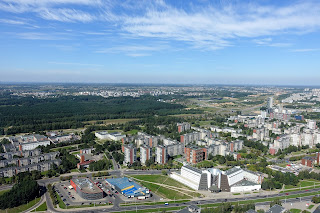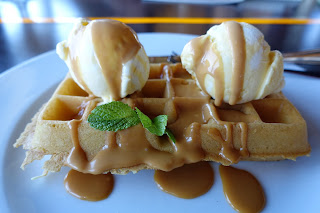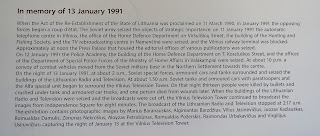Dour, 電通-controlled, family-centric Belgian Neocolonialism, enthusiastically jaded observations, support for state-owned neoliberalist media and occasional rants from the twisted mind of a privileged middle-class expatriate atheist projecting some leftist ideals with my ridicule of Tucker Carlson (from The Blogs Formerly Known As Sponge Bear and Kaminoge 物語) *see disclaimer below
Sunday, August 28, 2016
High above the tanks
Saturday was my wife's birthday. Concerns for my personal safety prevent me from stating which birthday it is, but suffice it to say she's younger than I am and will always remain that way. My daughter and I had planned on taking her to the local Burberry outlet, but Shu-E doesn't like spending money, even on herself, and considered the smartphone she'd purchased a couple of weeks ago an early birthday gift. Instead, my wife took a look out the living room window at the clear blue sky and suggested that this day would be a good day to visit the TV Tower (Televizijos Bokštas), which stands 326 meters (1070 feet) high in the western suburbs of Vilnius. The tower isn't merely a television signal transmission source; it's also a poignant symbol of Lithuania's struggle to free itself from the yoke of Soviet oppression. On the night of January 13, 1991 14 people were killed resisting the Soviet army's attempts to take control of the TV tower; a dozen were shot and two were crushed by tanks, with Lithuanian TV continuing to broadcast until soldiers finally burst through the door of the structure. As we approached the TV Tower after parking our car (our apartment building being only a ten minute-drive away), we passed a collection of crosses serving as reminders of that terrible event of 25 years ago:
After buying our admission tickets, we rode the elevator to the observation deck, sited 165 meters (541 feet) above the ground, and began taking in the views:
The observation deck also includes a revolving restaurant called Milky Way (Paukščių Takas); we found an empty table, ordered lunch and sat back to enjoy the view (a full rotation takes around 50 minutes). TV monitors showed the history of the tower, including it's role in the January Events of 1991:
Naturally, the occasion called for a drink:
Continuing to take in the views while we lunched:
Dessert was a Belgian waffle covered in caramel sauce. My excuse? It was Shu-E's birthday, remember?:
An attempt to zoom in on Old Town, struggling to focus on Gediminas Castle and the Three Crosses:
We spent around 2½ hours in the revolving restaurant and observation deck. The food wasn't bad, and the views are such that we might want to return on a clear night for dinner:
Back on the ground floor, where there's a memorial to the victims killed by Soviet troops:
While my sun-averse wife took shelter in the shade, Amber and I took a walk around the TV Tower, checking out a collection of old antennas and a small playground:
In the evening we walked into Old Town to have dinner at a restaurant called Trinity. Sitting outdoors on a warm summer evening, with an 18th-century baroque and rococo church towering over us is the kind of experience I never enjoyed in Taiwan (or anywhere else in Asia or the U.S., for that matter):
The food at Trinity is sort of an Asian-Lithuanian fusion, whatever that actually means (sounds hip, though):
While we were dining, hot air balloons from the local ballooning center floated overhead, close enough for us to see the flames, but too high to get any decent photos:
My daughter took this picture of St. Catherine's Church as the sun was getting ready to make its exit. The twin spires are visible from our living room window:
Amber plays Pokémon Go while walking through the streets of Old Town on the way home from dinner:
Sunday wasn't as bright and clear as the day before, but it was warm and Shu-E agreed that another cycling trip through Old Town was in order. Gediminas Prospektas was roped off again for another cycling event, though this one was a lot more competitive than last week's family-friendly fest. The packs of cyclists whooshing along the street following (and being followed by) pace cars served as a backdrop while we had lunch at Soya, a local Asian cuisine chain where I enjoyed a tori bento:
A nearby signboard promotes an upcoming Japanese culture festival, something that might be worth checking out:
Our ride following lunch took us up to the Hill of Three Crosses. Well, not quite - the steepness of the road proved too much for our out-of-shape stamina reserves so we ended up walking the bikes up to the top. The first wooden crosses on this hill were erected in 1615, but were removed by Russian authorities after a revolt in 1863. A concrete monument was put up in 1916, only to be destroyed later by the Soviet administration. These three crosses, designed to commemorate 14 Franciscan missionaries who were massacred by pagans on this site (or so the legend has it), have stood on the hill since 1989:
The vista looking out over Old Town is pretty fab, of course. Gazing toward the TV Tower in the distance, I noted to my daughter that exactly 24 hours previously we were enjoying the opposite view. Amber wasn't particularly impressed with her father's keen insight:
From the Three Crosses we cycled over to the neighborhood known as the Užupis Repubic (Užupio Respublika), a breakaway "state" declared in 1986 by the area's artists and squatters. Visitors come to see the Užupis Angel, a statue of a trumpeting angel erected in 2002, and the 41-point Užupis Republic Constitution, engraved on a wall in a number of different languages (including Mandarin, much to my wife's joy). My photo of the angel turned out blurry for some odd reason (I'll be back; our dentist is in the same neighborhood), but I did get some decent shots of the constitution. It guarantees among its points the right to be free, to be happy (or unhappy), to be unique and to love, of course. It also states that "a cat is not obliged to love its owner, but must help in time of need" (point #13):
We took a break at Užupio kavinė, a cafe with a prime spot along the Vilnia River:
The shot of the cafe above (you can barely make out the heads of Shu-E and Amber under the edge of the furthest-to-the-right umbrella) was taken from the main bridge leading into Užupis. Under the bridge dangles a wooden swing, just above the Vilnia. My daughter wanted to wade over to it to have a seat, but I was concerned about the canoeists coming around a bend in the river. My parental instincts proved correct as several boats collided with the swing while we were sitting on the cafe's decking:
A shop specializing in Tibetan crafts, unfortunately closed on weekends, is indicative of the kinds of businesses found in Užupis and why the neighborhood merits further exploration in the future:
On the way home we stopped at Senamiesčio Krautuvė, an old-style Lithuanian grocery store which Shu-E and I had previously visited, where Amber picked up a couple of snack treats for school, which starts tomorrow:
The return to school (in the fifth grade already?!) signifies that summer will soon come to an end. I can't think of many places more pleasant to spend a summer in than Vilnius. I've also been told that fall in Lithuania is also nice. Winter, on the other hand...Better to enjoy the present and worry about the future later, which is what I'm doing now at 6:40 p.m. on a Sunday evening, looking up from my laptop to enjoy the sunlight reflecting off the spires of the above-mentioned St. Catherine's Church.
Monday, August 22, 2016
All Quiet on the Lithuanian Front
The struggle faced by most Lithuanians as they try to eke out a living in this impoverished country
Sometimes, no news is good news. And so, with nothing of note to report on the Kaminoge home front, here are a few photos from the past week in Vilnius...
On Wednesday I took part in a walking tour of Jewish-related sites in Vilnius' Old Town. While the guide was well-informed on the topic, the weather was cold and rainy and the tour wasn't quite what I was expecting in terms of what was seen. Still, in how many other countries can you peer over the wall and into the rear garden of the Presidential Palace without getting arrested?:
You can always play a game of chess on this elephant-shaped board while waiting for something to happen in the garden:
Our guide stands beneath a map showing the locations of the World War II-era Jewish ghettos in Vilnius:
A quiet courtyard located in the former ghetto:
In contrast for most of the past several weeks, the weather this weekend has been nothing short of gorgeous: sunny skies and warm temperatures (in the low twenties Centigrade). Glad to see summer decided not to check out early, after all. My family and I celebrated the return of the sun by making yet another short drive to Trakai (we were just there last weekend) - if I were Lithuanian, I would consider buying a dacha in the area for those quick weekend getaways. We parked in front of the Trakai History Museum, and so made it our first stop. The ecclesiastical art display in a former Dominican monastery was of mild interest but not worth the addtional €1.50 being asked for the privilege of taking photographs (on top of the regular admission fee). No such restrictions exist, however, on the grounds of the Peninsula Castle, completed in 1382 and destroyed in the 16th century:
Lamb pie and a cup of broth for lunch, washed down with a Švyturys White - Baltas Hefeweizen, at the Karaimų 13 cafe:
Lots of watercraft on Lake Galvė:
Ostensibly we traveled to Trakai again to see the Days of Ancient Crafts, which was supposedly developed from a medieval festival that was held at the Peninsula Castle. However, a quick peek inside the gate of Trakai Castle showed a lot of stalls selling crafts and snacks, a few people dressed in medieval costumes and not much else. Was it worth paying the entrance fee to see the castle again? Considering we had done just that only two months ago, then answer was no:
Instead, we took a sightseeing boat on a tour of Lake Galvė, where the previously noted various types of watercraft were joined by a powered parachute flying overhead:
My daughter enjoys an after-cruise triple-scoop ice cream (chocolate, mango and strawberry):
Dipping our feet in the cold (but not unbearably so) waters of Lake Galvė. Cap by Sacramento River Cats, jersey by Southend United F.C., circa 1996 (hey, I take good care of my clothes):
Looking across Lake Totorškių, on the opposite side of the peninsula from Trakai Castle, as we were heading back to our car for the drive home. Next summer I'd like to stay a night at a hotel close to the water in Trakai:
Back in Vilnius and having a "New York" deep-dish pizza at an American-style restaurant a short walk from our apartment building:
My wife and child are not immune to popular fads and trends. Shu-E recently downloaded the Pokémon Go app, and here Amber checks out a "Pokestop" - a statue of Florence Nightingale near the 24-hour flower market on Jono Basanavičiaus gatvė (because there are people out there who need to buy flowers at three o'clock in the morning):
The view toward Old Town in the distance on a late Saturday evening:
Sunday was another beautiful day, and with our bikes finally out of storage and ready to ride, we set off just after twelve-thirty in the direction of Old Town, stopping for lunch outdoors at Zoe's Bar & Grill, across from Cathedral Square:
The menus at Zoe's are designed to resemble LP sleeves, and contain actual 33 1/3 rpm records inside them (the smaller drink menu has a 45-rpm record in its sleeve). So I instantly aged several decades when my millennial daughter pulled one of the records out of her menu and asked me what it was:
The Thai-style shrimp rolls were pretty good:
The next profile photo for my Facebook page, beer gut and all:
Ready to ride. In the background is Vilnius Cathedral, arguably the city's top tourist sight and one we haven't visited yet. When you have twenty-one months remaining in a place, there's no hurry to see everything:
Today also happened to be the Velomarathon, the biggest bicycle event in Lithuania. We didn't take part (wait 'til next year!), but we did ride along part of the route:
This large ball hanging from the Žirmūnai Bridge (Žirmūnų tiltas) is an art installation. We had passed under it back in June when we took a sightseeing boat on the Neris River:
The Vilnius Palace of Concerts and Sports (Vilniaus sporto rūmai) is a typically hideous Soviet-era architectural monstrosity that sits on the opposite side of the Neris River from Gediminas Castle. It closed down in 2004, and now begs for urban exploration. Only with my present occupation, what the Japanese call 廃墟巡り wouldn't be the smartest thing for me to do:
Behind the decaying "palace" is a track-and-field stadium in the process of being razed:
Vilnius is a city that begs to be explored on two wheels, at least until it gets too cold and dark to do so:
Utenos Alus is a Lithuanian brewery that is part of the Carlsberg Group. It puts out some good beers despite that fact, including a refreshing raspberry radler. And I'm confident enough with my sexuality to publicly admit that:
Location:
Zoe's Bar & Grill
Subscribe to:
Posts (Atom)










































































